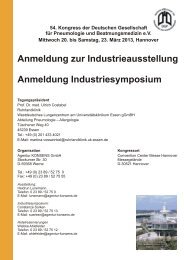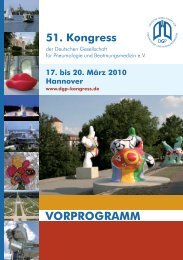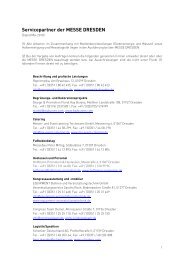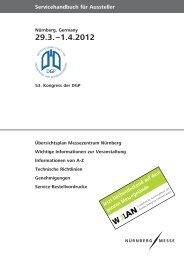Instruction Sheet - Agentur KONSENS
Instruction Sheet - Agentur KONSENS
Instruction Sheet - Agentur KONSENS
Create successful ePaper yourself
Turn your PDF publications into a flip-book with our unique Google optimized e-Paper software.
Technical Regulations (continued)<br />
4.7.5.2 Attaching objects to suspension points<br />
The objects to be suspended (lighting bars, spotlights, beamers,<br />
loudspeakers, etc.) may only be mounted by the exhibitor's own<br />
skilled staff, approved contractors or the ServicePartner in<br />
accordance with current engineering practice and the regulations<br />
in force in Germany and/or the EU.<br />
Further information on approved and non-approved attachment<br />
gear, load-bearing lines, load-bearing equipment, fasteners, rope<br />
terminations and lifting equipment can be obtained from<br />
<strong>Instruction</strong> <strong>Sheet</strong> i4.9 “Suspension points, trusses and lifting<br />
equipment”.<br />
The regulations listed below must also be observed for safety<br />
reasons.<br />
The following are prohibited:<br />
- Suspension points used for securing stand components or<br />
exhibits (stand components or exhibits must stand securely on<br />
their own)<br />
- Suspended constructions with a rigid or non-positive connection<br />
to the hall floor<br />
- The use of bridle suspension points<br />
Exceptions require the prior written approval of NürnbergMesse.<br />
4.7.5.3 Use of truss systems<br />
The use of trusses, rigs and truss systems is governed by the<br />
requirements and implementation instructions of BGV C1/ GUV<br />
C1, BGI 810-3 (2007) and the industry standard SQ P1. This is<br />
independent of the type of use of the trusses, rigs or truss<br />
systems, which can be hung, moving or ground-supported.<br />
The use of trusses, rigs and truss systems outdoors is governed by<br />
the requirements for “temporary structures” (German FlBauR)<br />
(see DIN 4112 – Temporary structures; code of practice for design<br />
and construction/DIN EN 13814 – Temporary structures and<br />
systems for event venues and safety in amusement parks).<br />
For rigs that cannot support the load of a single-section girder<br />
(girder/truss on two supports or two suspension points), evidence<br />
of structural strength may be requested at the exhibitor's cost.<br />
The data sheets must be enclosed for the trusses used. If temporary<br />
structures are used, the inspection log must be enclosed.<br />
4.7.5.4 Use of lifting equipment<br />
The use of lifting equipment (electric chain hoists, manual chain<br />
hoists, etc.) is only possible in halls 4A, 7A and 11 and requires<br />
prior approval by NürnbergMesse.<br />
The use of lifting equipment (electric chain hoists, manual<br />
chain hoists, etc.) in halls 1, 2, 3, 4, 5, 6, 7, 8, 9, 10 and 12<br />
is strictly prohibited!<br />
The use of lifting equipment is governed by the requirements and<br />
implementation instructions of BGV C1/ GUV 6.15 BGI 810-3<br />
(2007) and the industry standard SQ P2.<br />
4.7.6 Stand partition walls<br />
The stand partition walls are fiber board or plastic-coated walls<br />
depending on the event. They are not suitable for mounting heavy<br />
objects and have no support function during assembly and<br />
dismantling. It may be necessary to erect additional supporting<br />
walls at extra cost, which may only be removed on the instructions<br />
of the organizer.<br />
4.7.7 Advertising materials, presentations<br />
The lettering on stands and exhibits, company logos and trademarks<br />
must not exceed the specified construction height and should<br />
create an attractive impression.<br />
Presentations and slow-moving visual and acoustic advertising and<br />
musical reproductions are permitted, provided they do not annoy<br />
neighboring stands, do not cause congestion in the gangways<br />
and do not drown out the public address systems in the halls. The<br />
loudness is not to exceed 70 dB(A) at the edge of the stand.<br />
15<br />
Info 4<br />
The distribution of printed matter and the use of advertising<br />
material are permitted only in the exhibitor's own stand space.<br />
Advertising structures inside the stand must not protrude into the<br />
gangways or be mounted higher than the approved height.<br />
Advertising that contravenes legal regulations or offends against<br />
moral standards is not permitted. Advertising packages or<br />
advertising material of companies not registered at the event must<br />
not be displayed. Exhibits are not to be set up outside the stand<br />
limits. Possible advertising offers can be found on the Exhibitors<br />
Info Manual under Marketing Services.<br />
4.7.8 Appearance<br />
The exhibitor is responsible for the design of the stand, which<br />
must be in keeping with the typical criteria for the event. Walls<br />
bordering visitor gangways should be made more attractive by<br />
installing glass showcases, niches, displays, etc. Rear walls that<br />
exceed a height of 2.50 m and are adjacent to neighboring stands<br />
should have a light, neutral and single color to avoid adversely<br />
affecting the design of the neighboring stand. The stand is to be<br />
designed to avoid corners that are difficult to control. Rooms that<br />
are only accessible via another room, which is also structurally<br />
separate from the generally accessible display rooms or via a<br />
corridor and do not possess any other exit or emergency exit are<br />
prohibited (“captive rooms”).<br />
4.8 Outdoor area<br />
See 3.2<br />
4.9 Two-storey stands<br />
4.9.1 Application<br />
Two-storey stands are only possible if approved by NürnbergMesse.<br />
The application must be submitted immediately after stand<br />
admission and at least 6 weeks before the event. The necessary<br />
application form is obtainable from the respective exhibition<br />
management team.<br />
Two-storey stands are not possible in halls 10.1, 11.1 and 12.2.<br />
4.9.2 Regulations on building over stand areas, safety clearances,<br />
height of rooms in stands<br />
The maximum height of structures is shown in the <strong>Instruction</strong><br />
<strong>Sheet</strong>: Hall details at a glance.<br />
The clear height of inside rooms of two-storey stands must be at<br />
least 2.30 m on the ground floor and upper floor.<br />
If a closed area of more than 10 m² is built over, a sprinkler<br />
system must be installed by the responsible ServicePartner BSS to<br />
protect the structure.<br />
Stand structures bordering on neighboring stands are to be<br />
finished in a light and neutral single color above the height of<br />
2.50 m.<br />
4.9.3 Permissible loads/load assumptions<br />
The stand safety certificates for a two-storey stand inside an<br />
exhibition hall must be based on the following loads in accordance<br />
with DIN 1055-3:2006-03:<br />
qk = 3.0 kN/m² Vertical load for ceiling for restricted use by<br />
visitors or stand staff for meetings and customer support, i.e.<br />
furnished with tables and chairs arranged at random or divided<br />
into conference cubicles.<br />
qk = 5.0 kN/m² Vertical load for ceiling for unrestricted use as<br />
freely accessible display and meeting area or as sales space with<br />
or without closely spaced seats.<br />
H = Σqk/20 (qk = vertical load) Horizontal load acting simultaneously<br />
with the vertical load at the height of the top floor to achieve<br />
sufficient longitudinal and lateral rigidity of the construction.<br />
qk = 1.0 kN/m Horizontal load at the height of the capping beam<br />
of hand rails and railings.<br />
qk = 5.0 kN/m² Vertical load for staircases and stair landings.<br />
It must be verified that the permissible load on the hall floor is not<br />
exceeded, e.g. by individual supports (see Item 3.1 “Hall details“).<br />
Please turn over!






